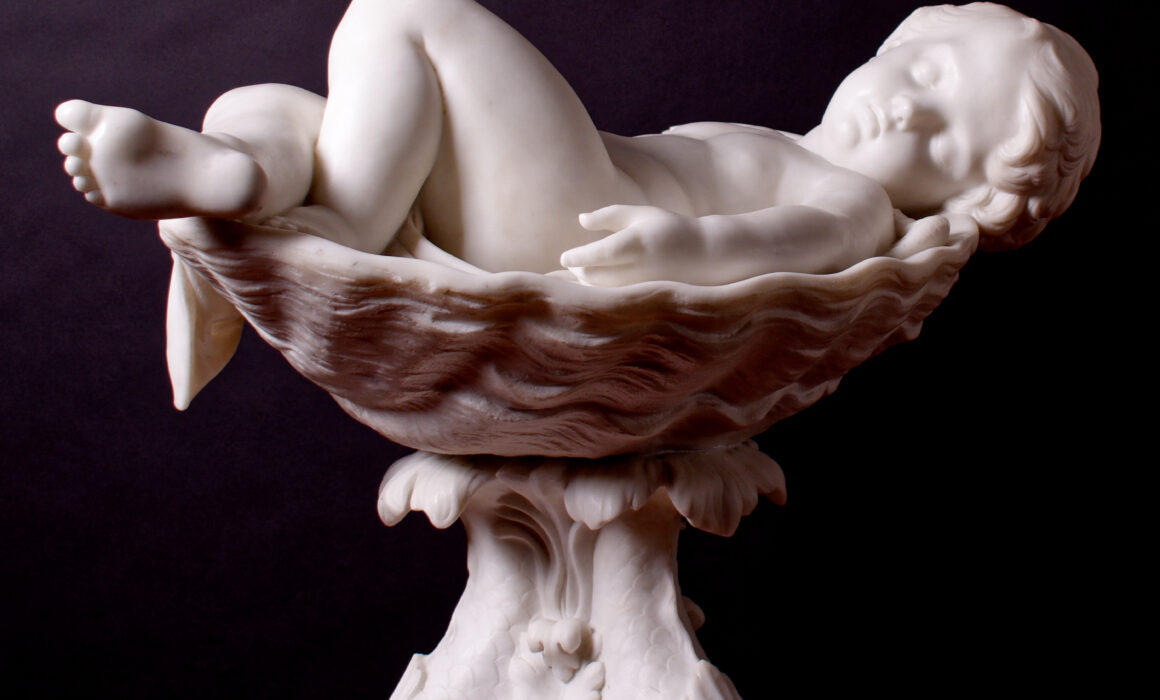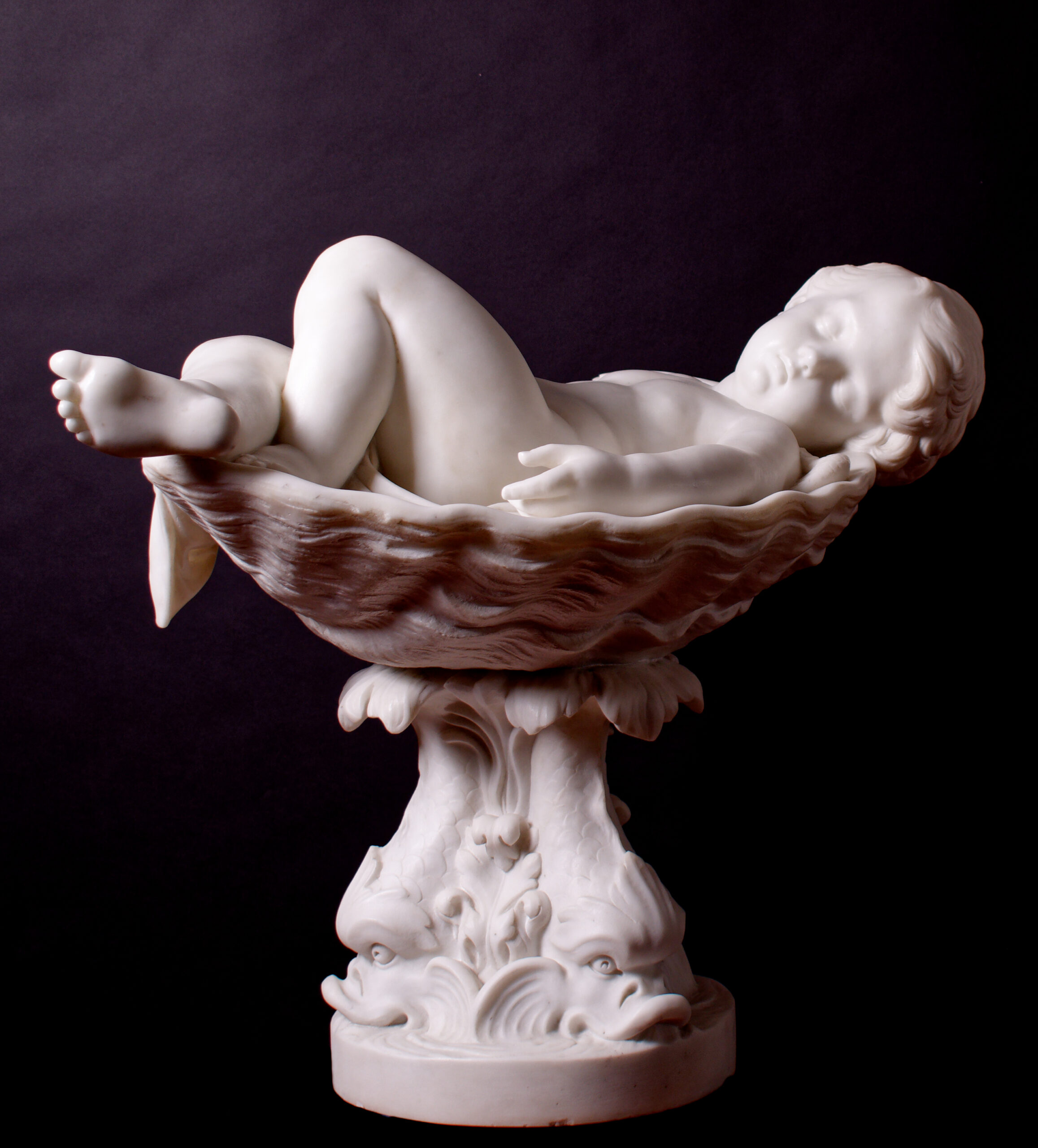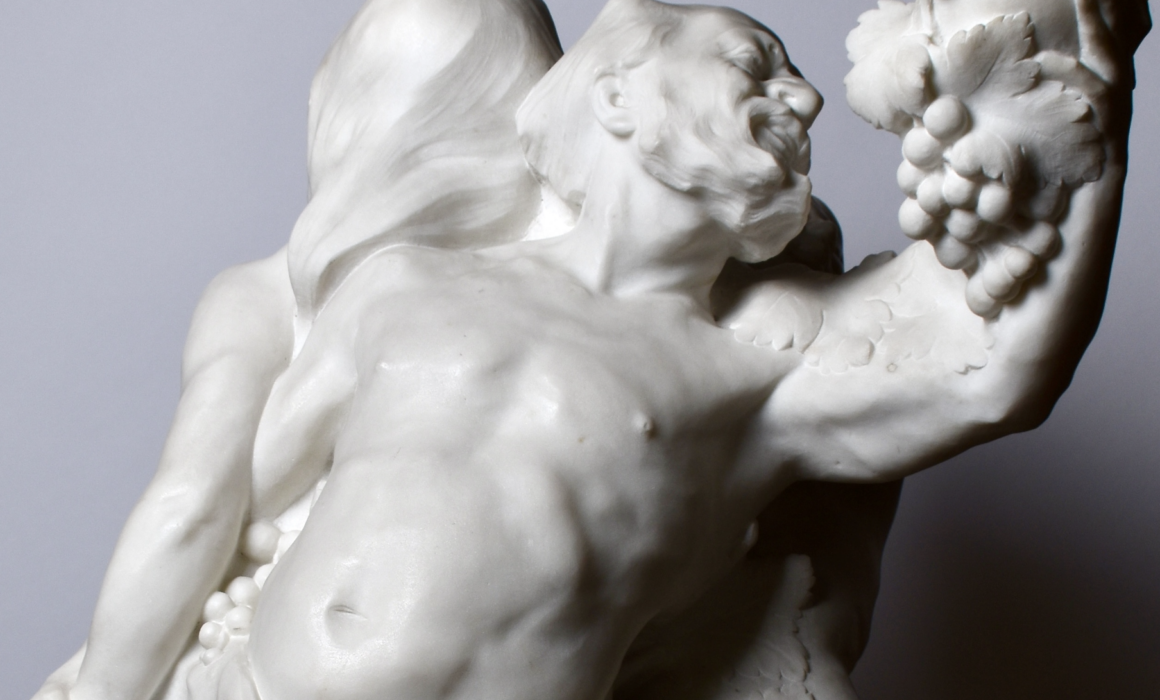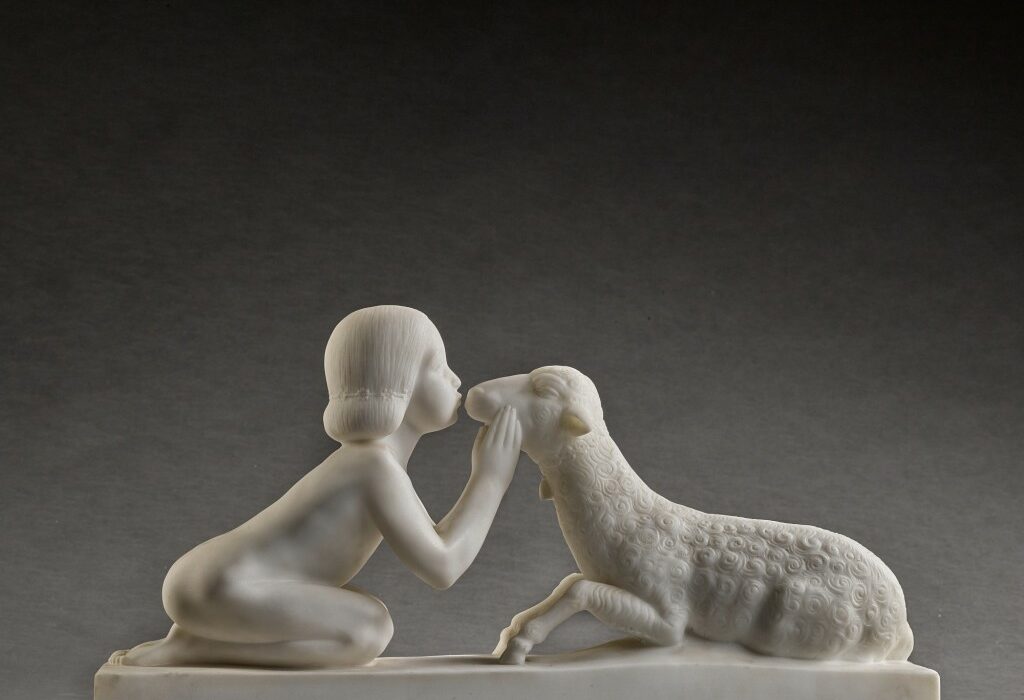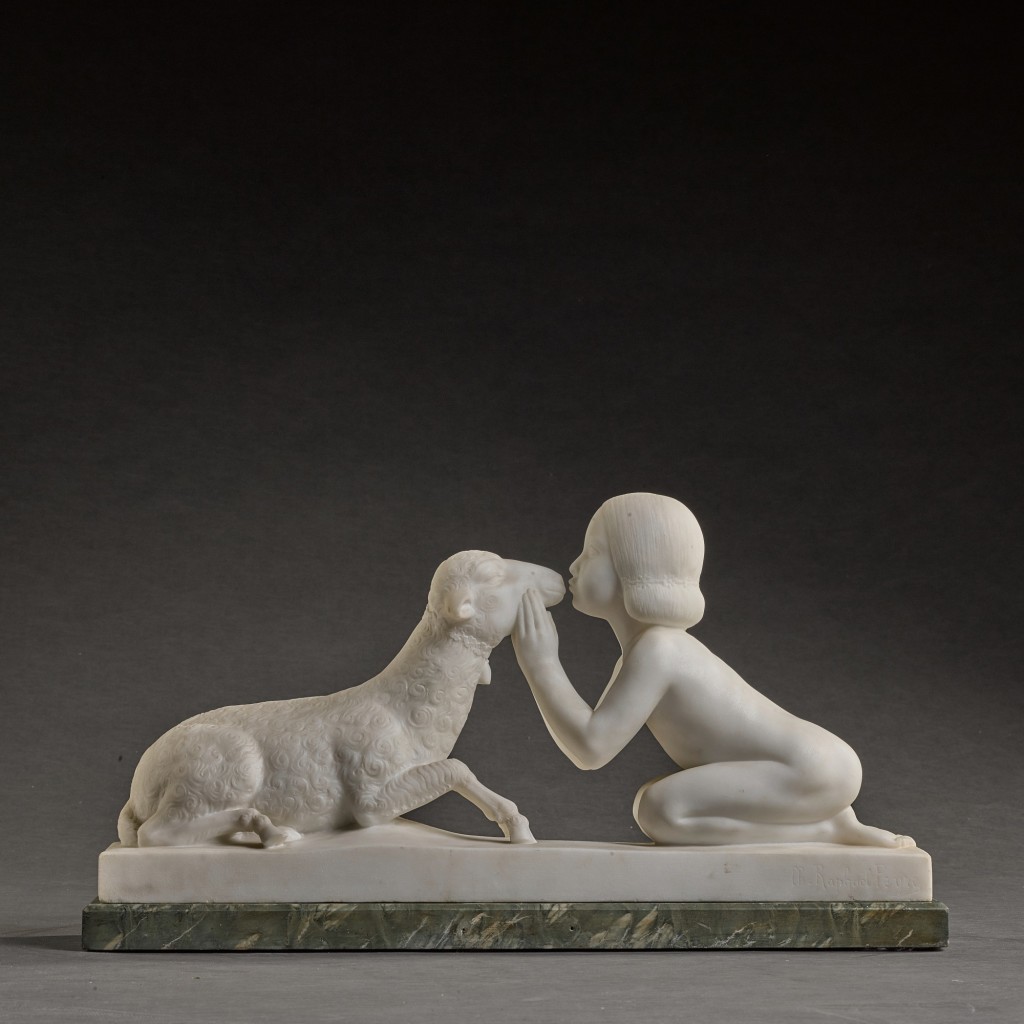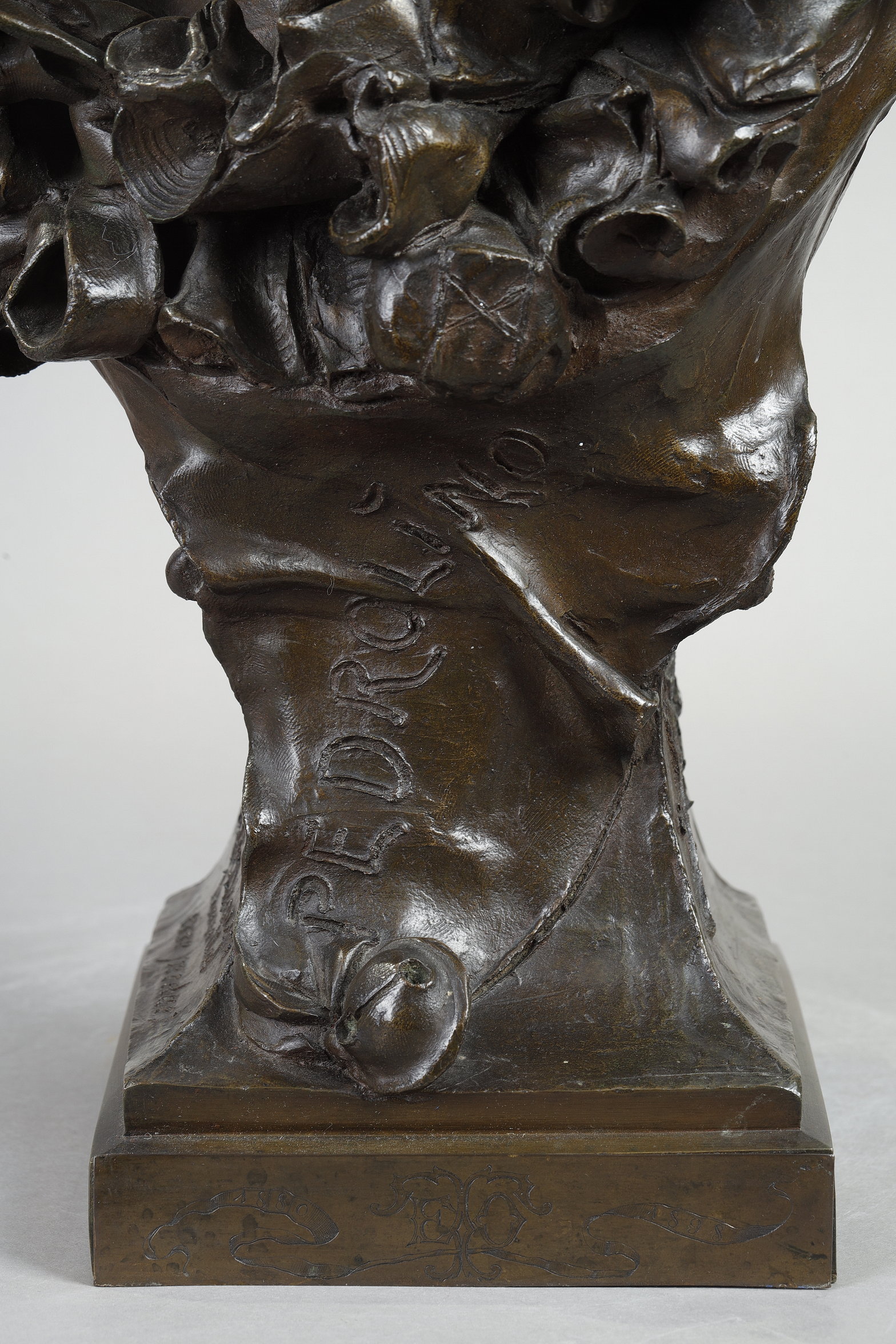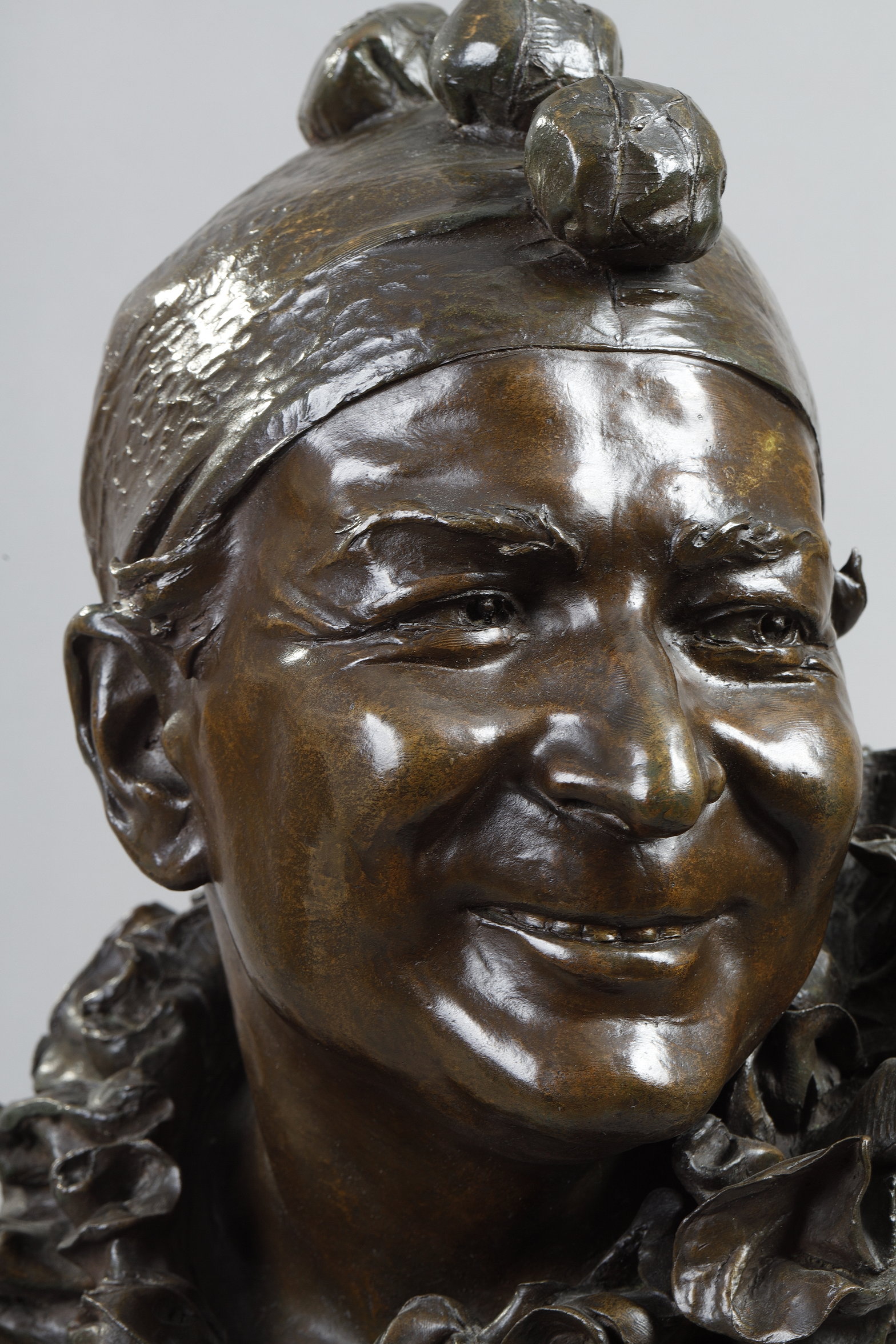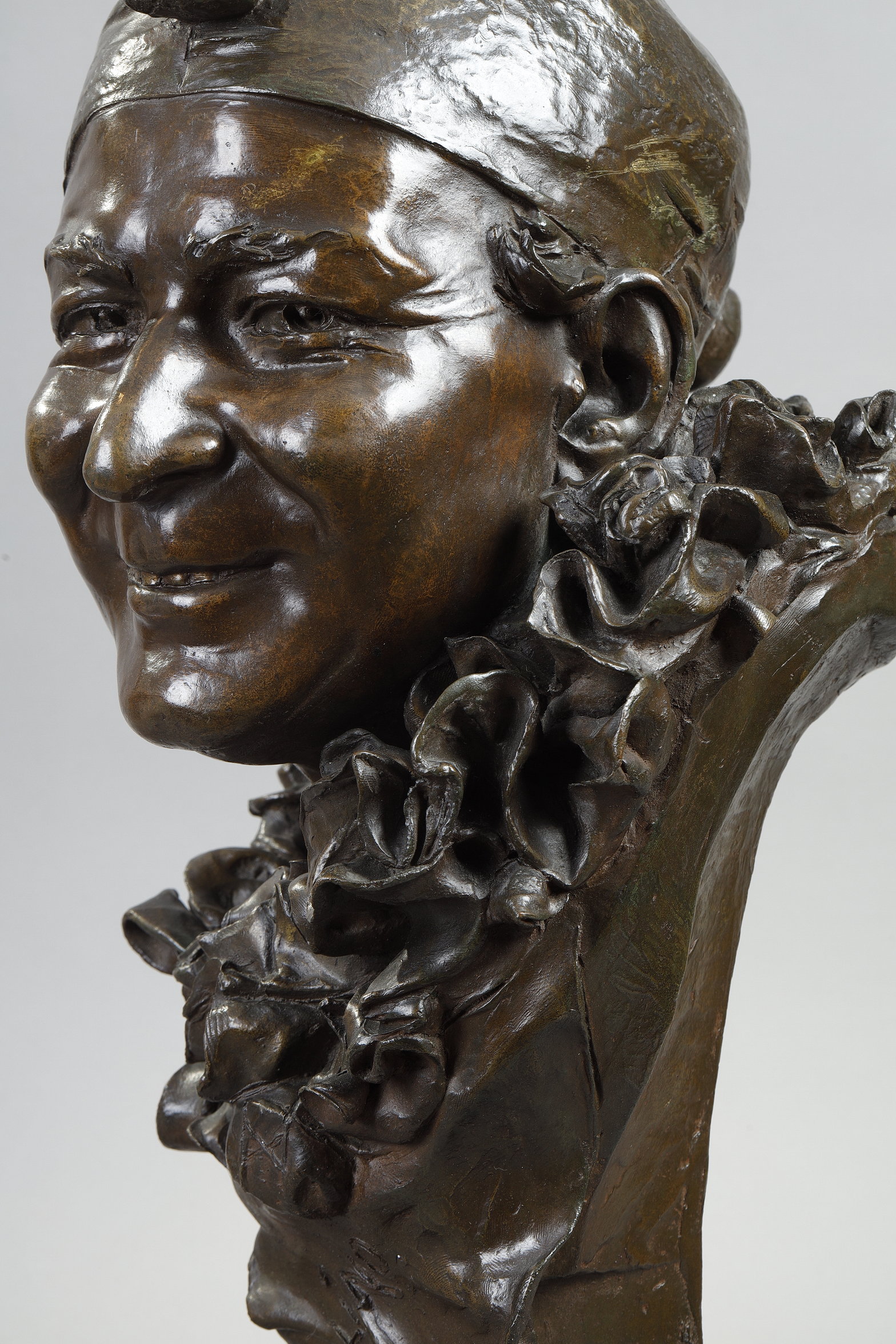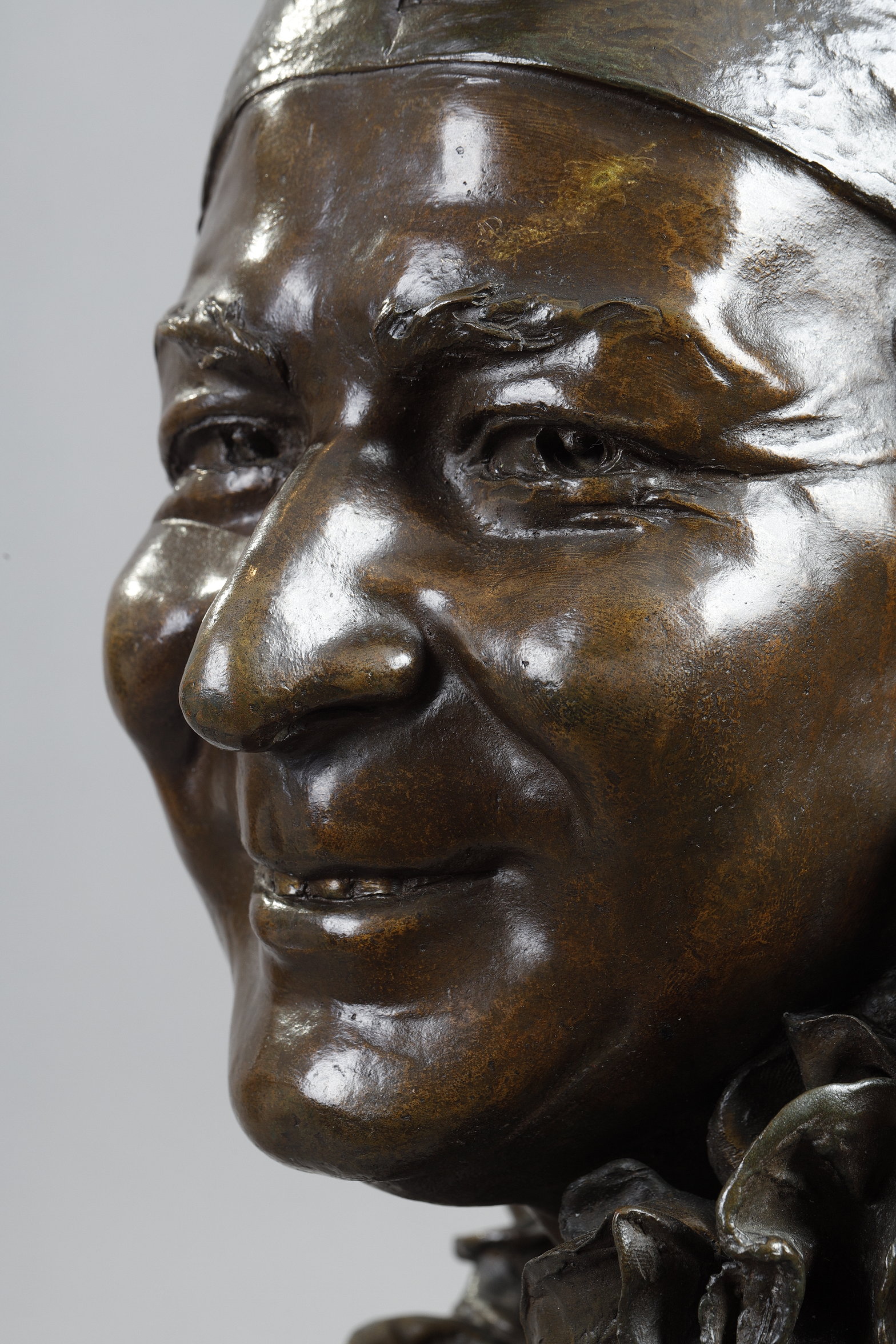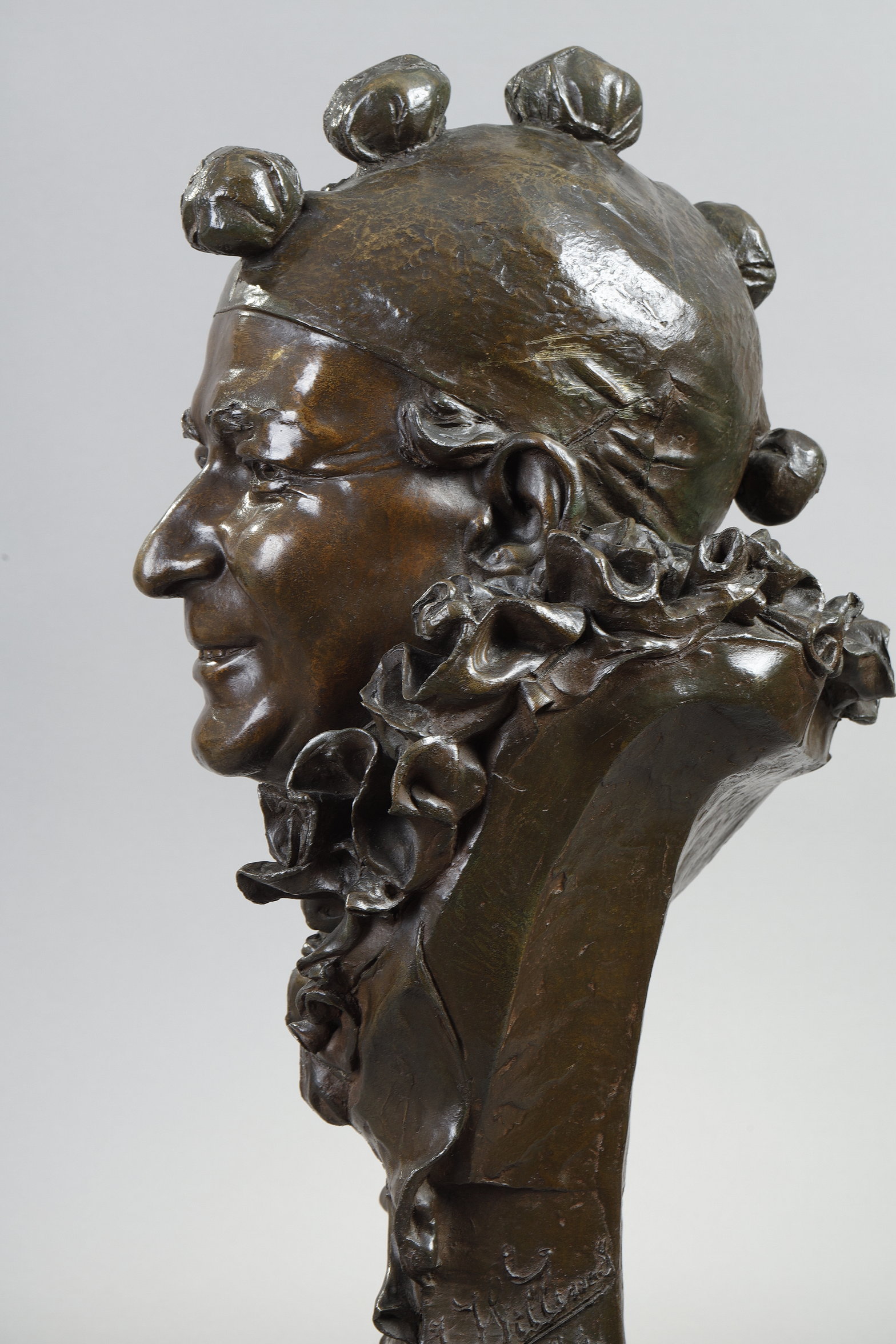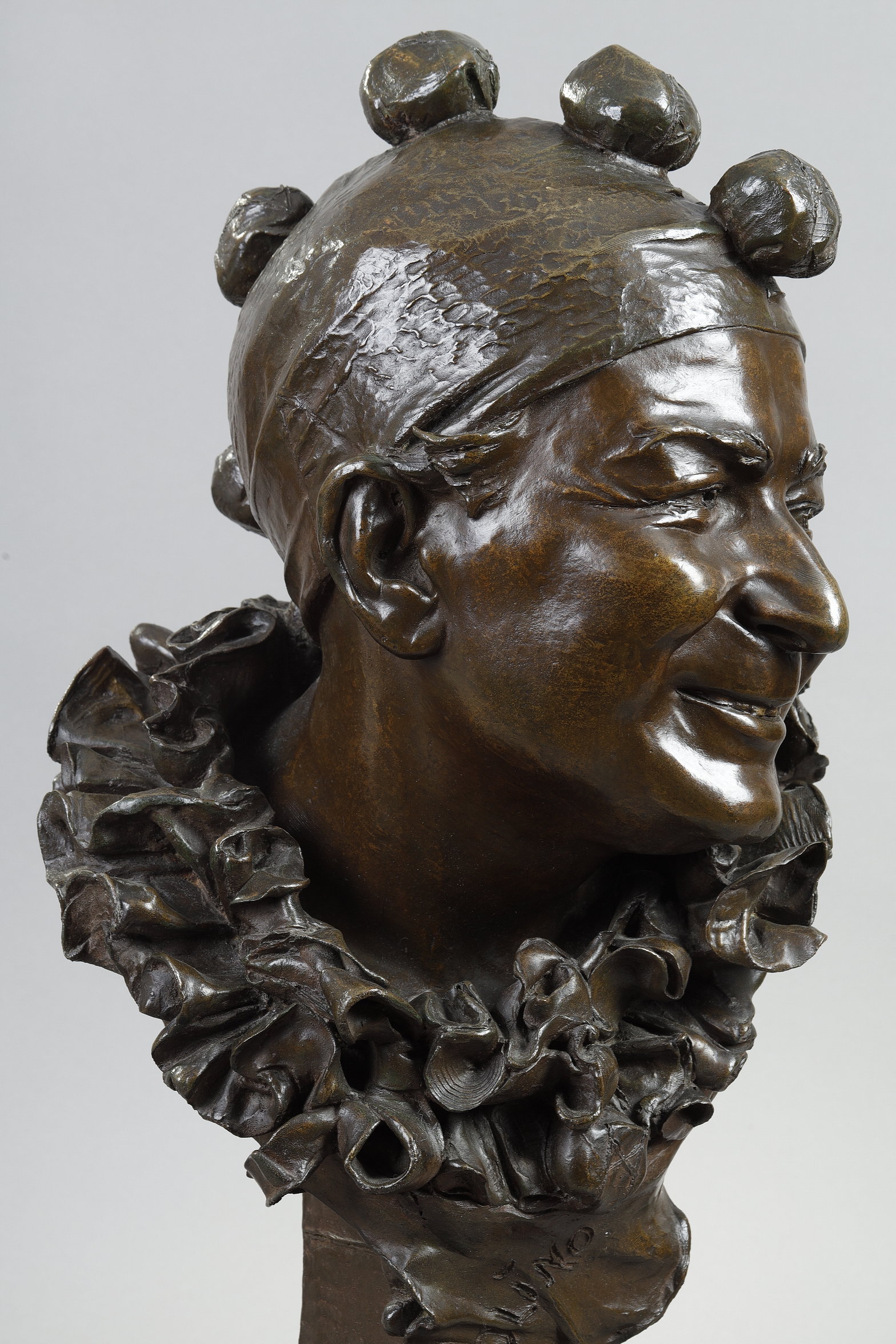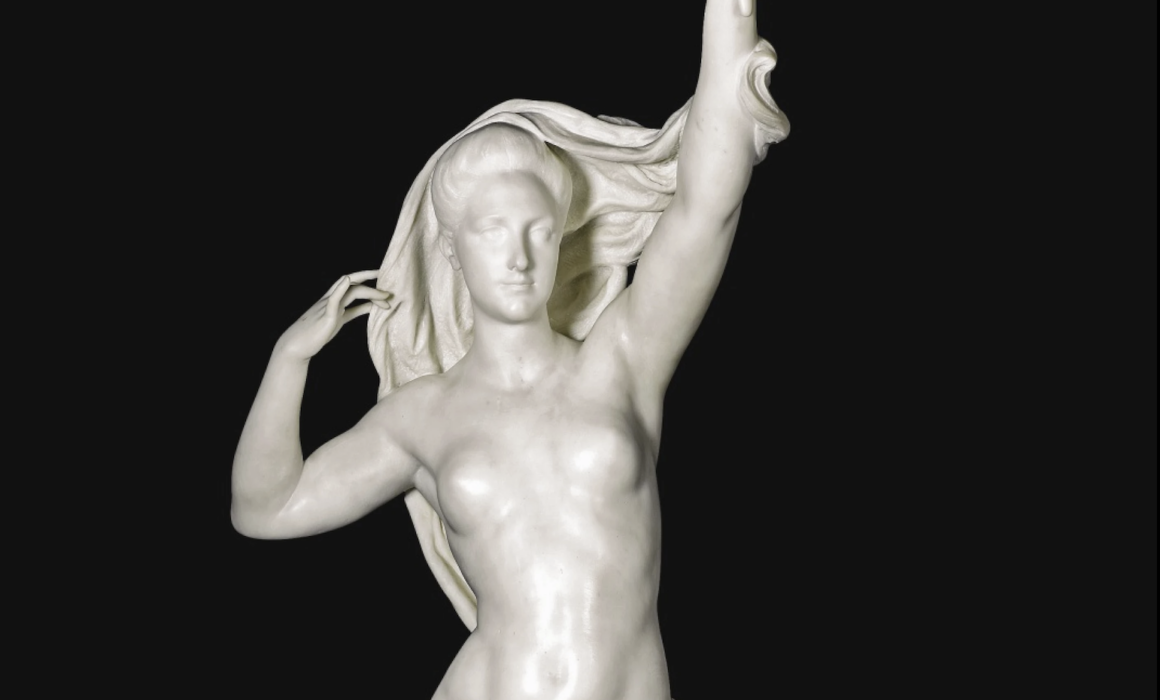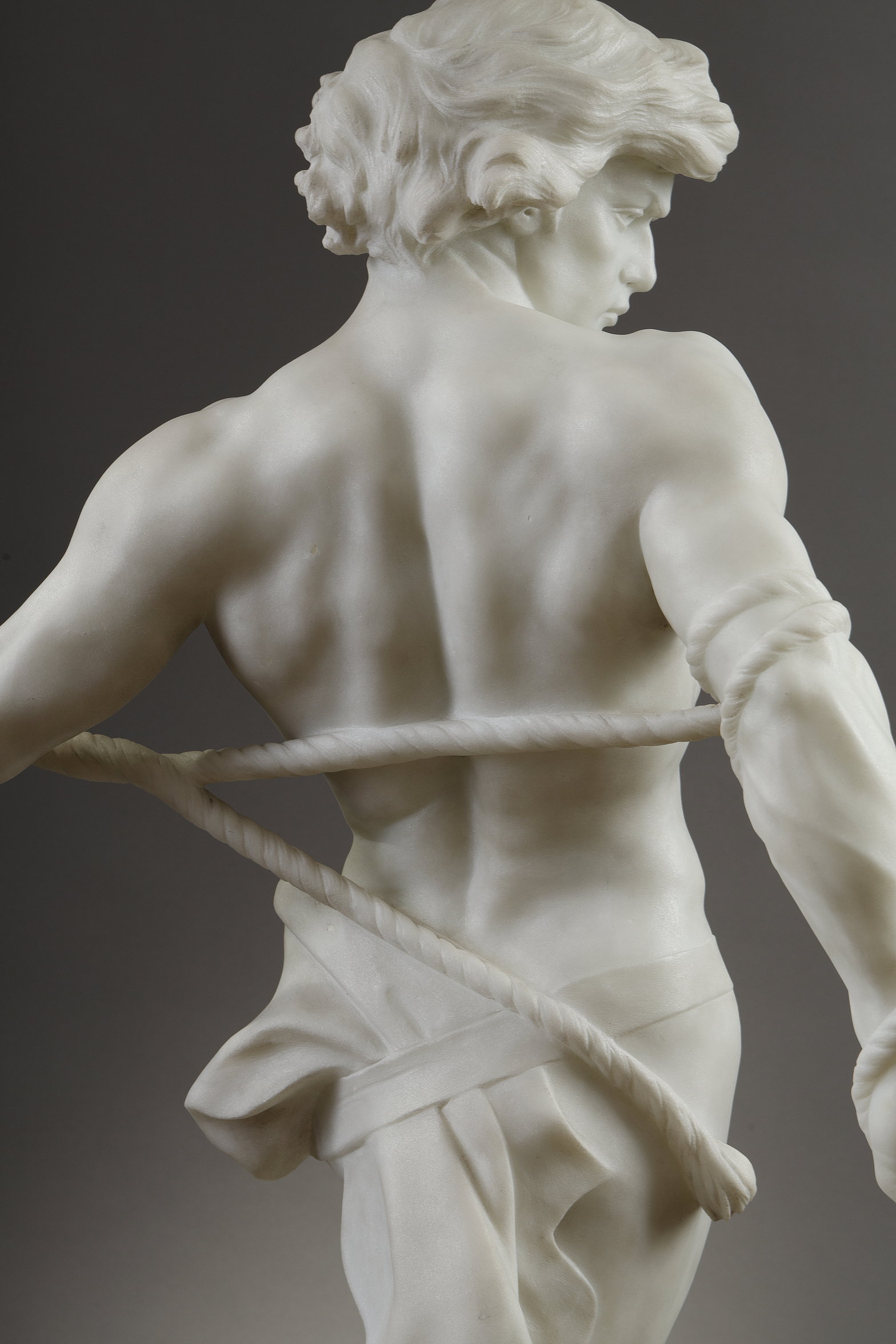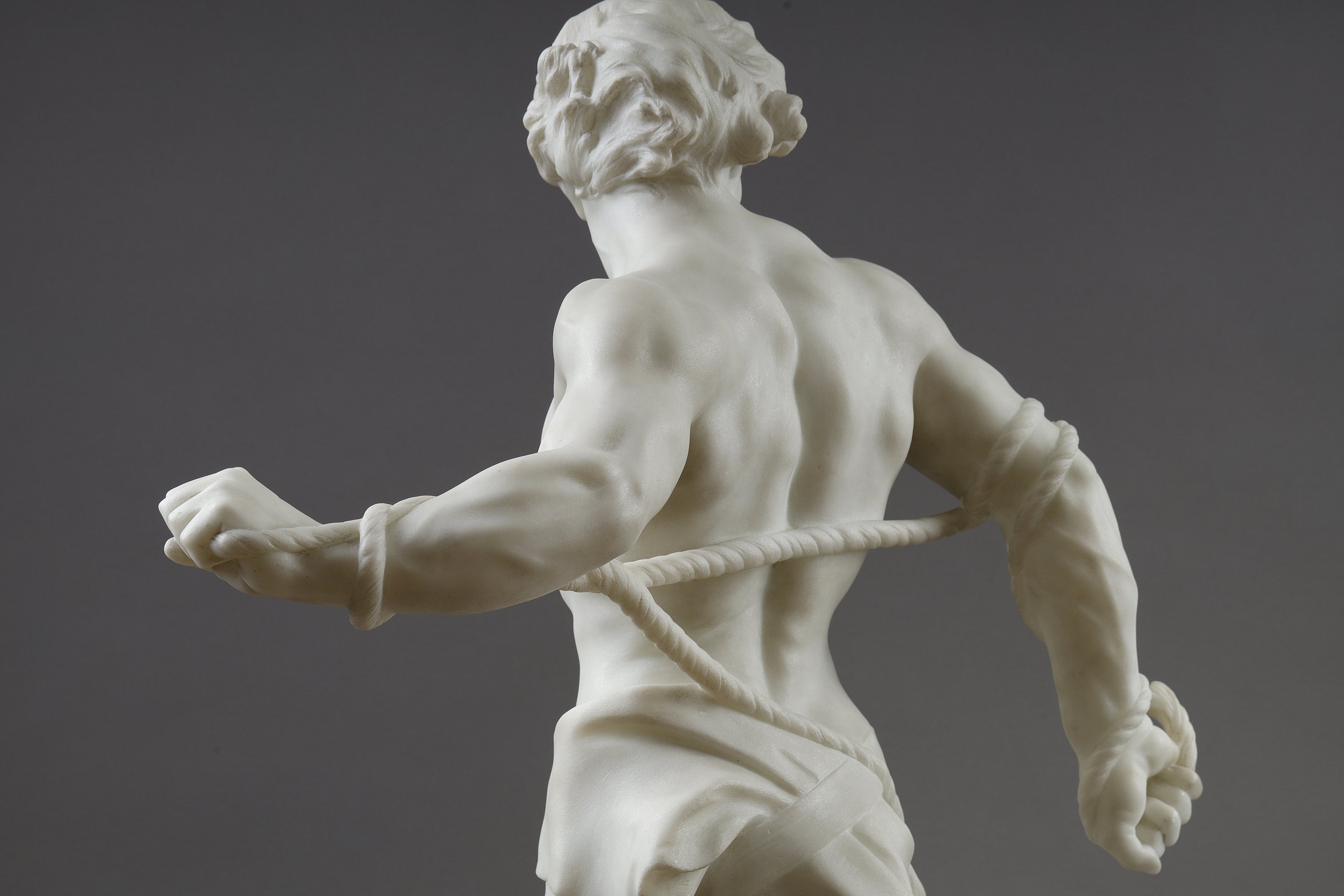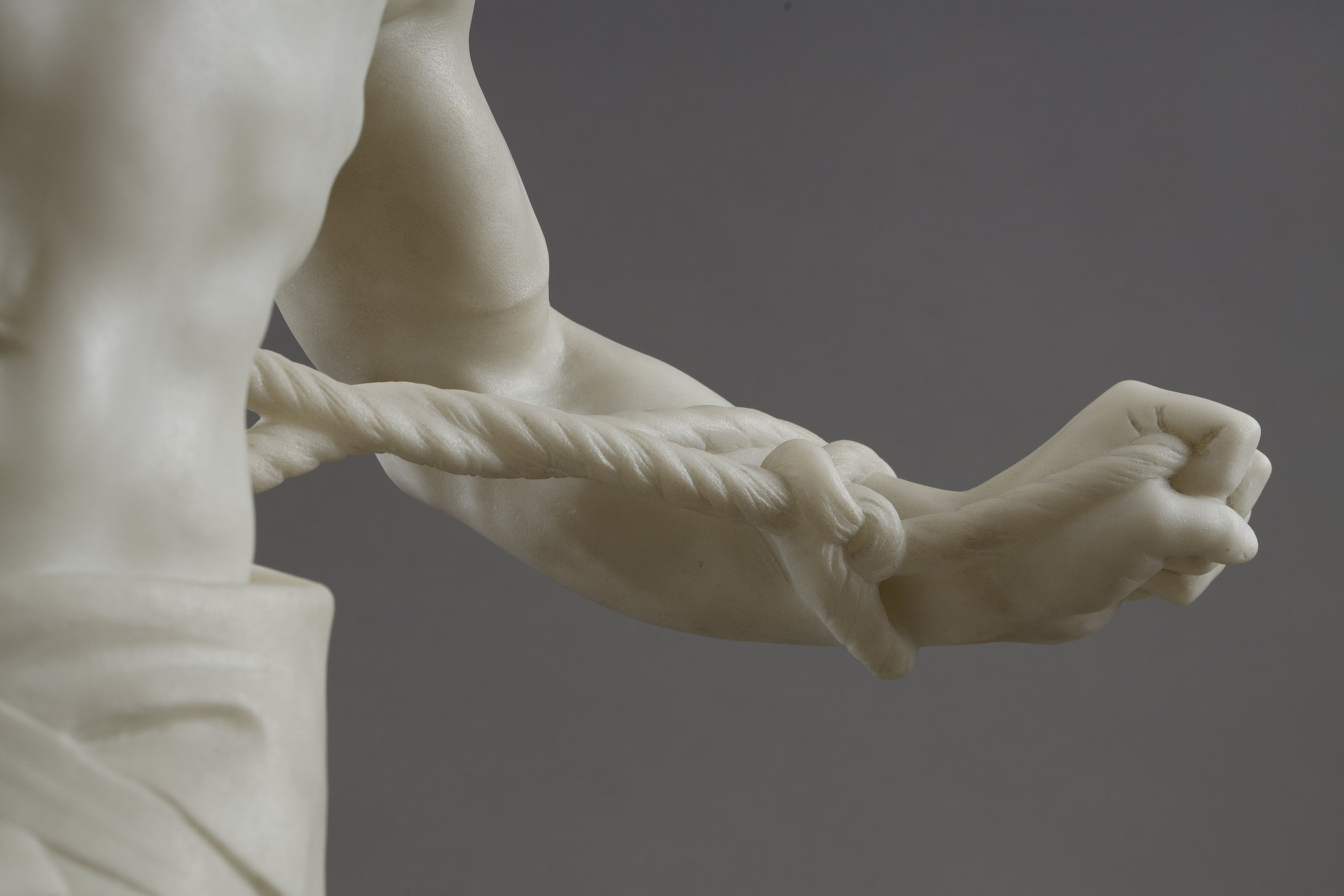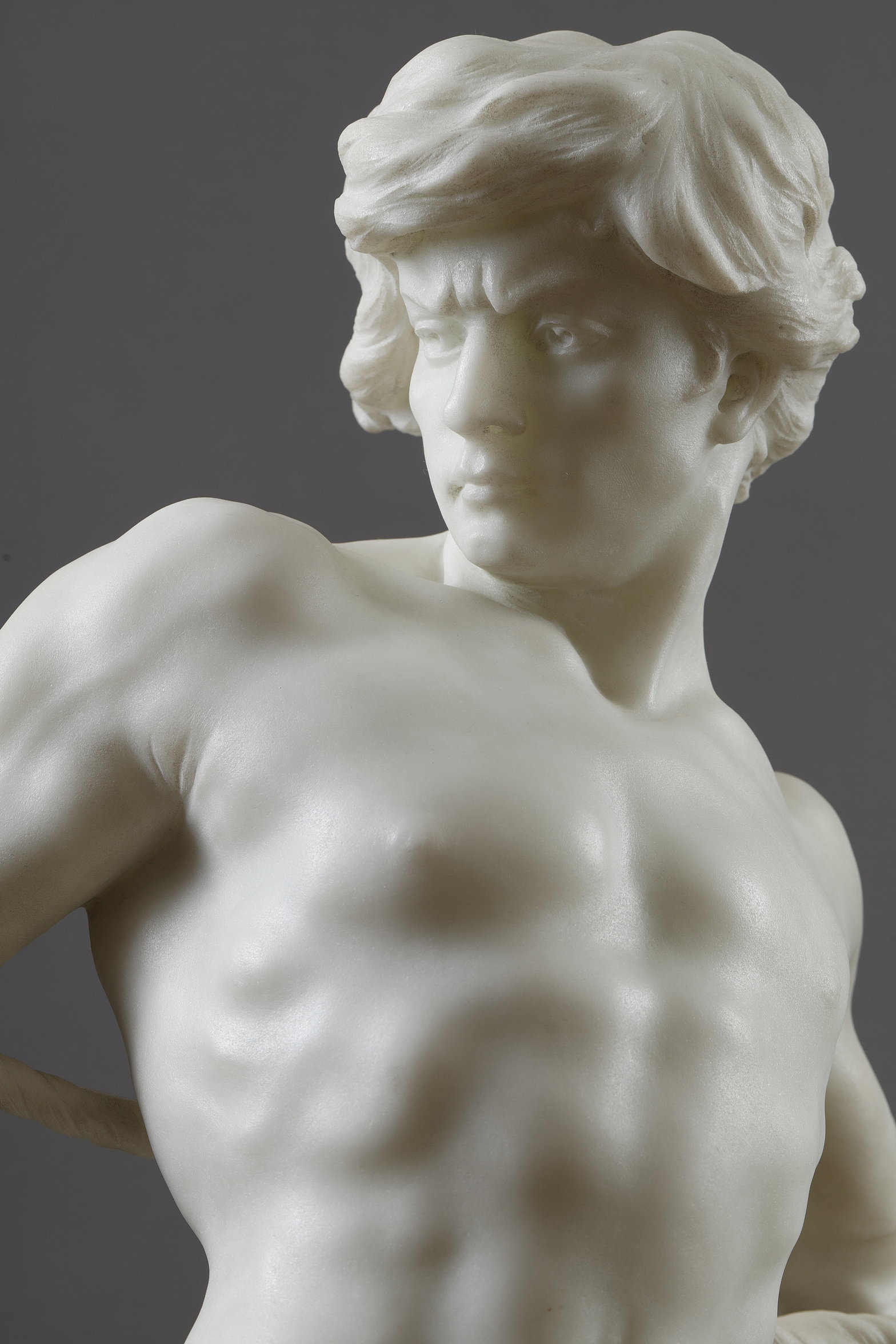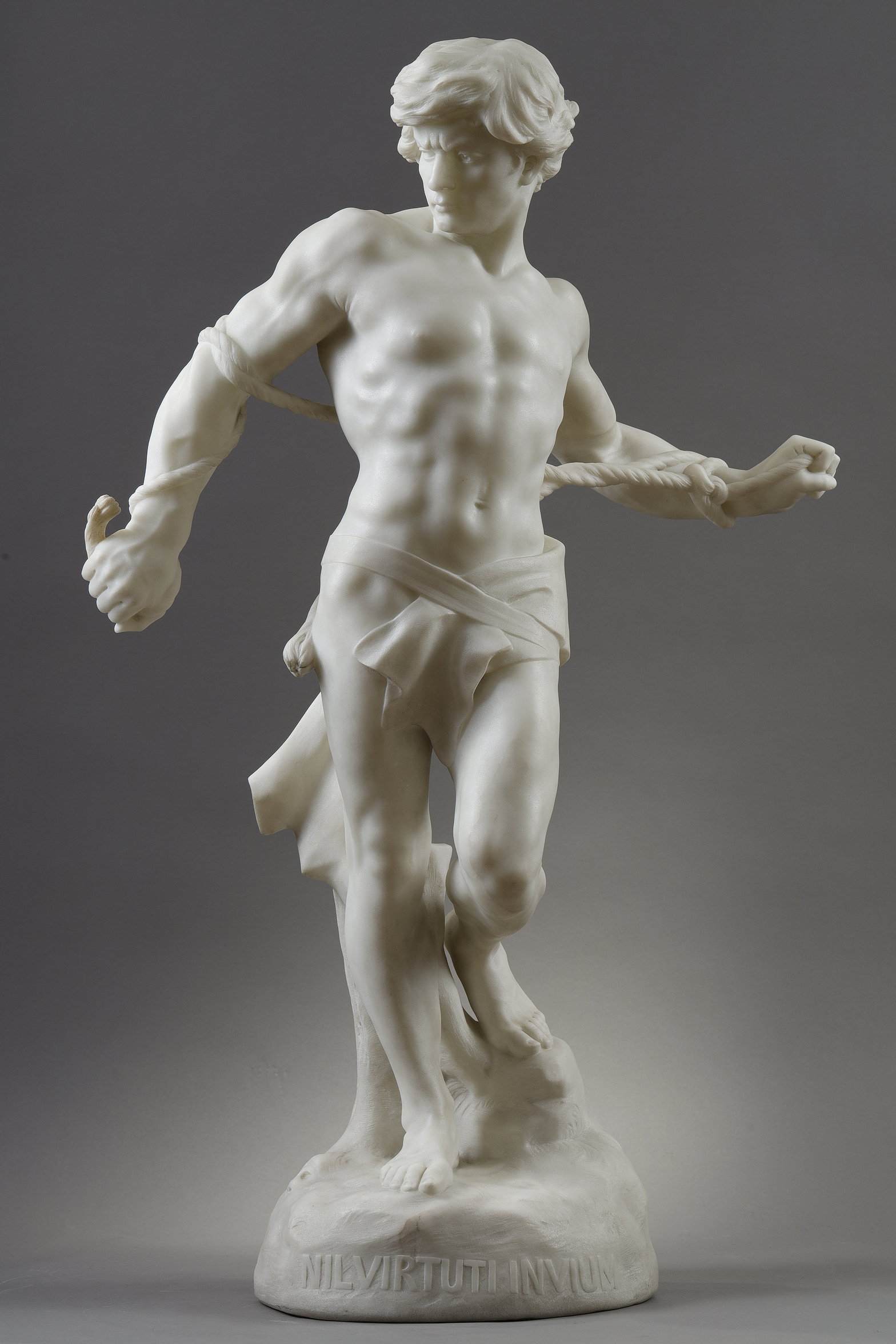FAUNA AND FLORA BY VINCENZO JERACE


FAUNA AND FLORA BY VINCENZO JERACE
Description
Marble model ordered by G. Caravita, Prince of Sirignano for his Palace in Napoli.
Material
-
- Bas-relief : Plaster with Terracotta patina
Signature
-
- Signed and dated, 1880
Dimensions
-
- 200,00 x 140,00 x 32,00 cm
Provenance
-
- First exhibition of the plasters in 1893, at the Münchens “Secession” an der Prinz Regent Strasse Nr – 76 (bears the labels).
- Private Italian collection.
LE VIN BY ALPHONS JOSEPH STRYMANS

LE VIN BY ALPHONS JOSEPH STRYMANS
Description
The sculptural work, masterfully executed in white Carrara marble, presents a refined figurative composition that reveals three human figures in dynamic interaction. The nuances and meticulously chiselled anatomical details attest to the exceptional talent and expertise of the sculptor Alphons Joseph Strymans. This grouping, comprised of two women and a man, all three nude, intertwine in a choreography evoking an ecstatic dance. Each figure holds a cluster of grapes, reproduced with remarkable precision, evidently symbolising the making of wine. A particularly striking note is the unconsciously dominant placement of a woman’s foot on the head the male figure serving as a point of support for the decadent trio. This composition, both graceful and intense, eloquently illustrates the effects of wine on the soul and human interactions.
The silhouettes of the figures merge harmoniously with the botanical motifs of vines, thus suggesting an intrinsic union between man and nature in their mutual inebriation. This masterpiece poetically evokes the idea that man and nature share a common essence – a profound origin.
The belgian sculptor Alphons Joseph Strymans (1866 – 1959)
Born on July 24, 1866, in Turnhout, Alphons Joseph Strymans passed away in 1959 in Antwerp. He distinguished himself as a cabinetmaker, draftsman, and above all as a sculptor. Trained at the art school of Turnhout, Strymans also benefited from the expertise of his father, a renowned cabinetmaker specialised in the creation of church furniture. This education bestowed upon him an exceptional mastery of sculpture in both wood and stone. His quest for excellence led him to pursue studies at the Antwerp Academy from 1886 to 1990, and then at the Higher Institute of Fine Arts in Brussels under the tutelage of Master Thomas Vinçotte. From 1898 to 1935, he shared his knowledge as a drawing teacher at the art school in Berchem. During this period, he also collaborated with eminent sculptors such as Frans Joris, Jules Weyns, and Josué Dupon, among others.
His artistic repertoire is vast. Throughout his career, he designed various ornaments for Art Nouveau furniture as well as sculptural works in bronze, ivory, and marble. From the beginning of the twentieth century, his works found their place in Antwerp, exhibited in museums and during prestigious events.
Besides his artworks, Strymans left his mark through various commemorative monuments and busts of notable personalities. Among his major accomplishments are the statues for the fishermen’s house in Antwerp, busts of the music critic Guy Davenel, the poet Max Elskamp, and the mayor of Berchem, Mr. Van Oombeek. Numerous prestigious institutions preserve his works. The Museum of Central Africa in Tervueren houses the ivory « The Daughter of Eve » and other remarkable pieces. The sculpture « Despair, » in bronze, can be found at the Dinant Museum, while one of his marble busts is proudly displayed at the Antwerp Museum
Period
-
- 1901
Material
-
- White Carrara marble
Dimensions
-
- Height 130 cm
Signature
-
- Signed and dated: « A. Jef. Strymans 1901 »
Provenance
-
- 2001, Artimo Fine Arts Gallery;
- 2004, private collection, Belgium;
- 2021, Artimo Fine Arts Gallery
SALTIMBANCA BY ENRICO ASTORRI
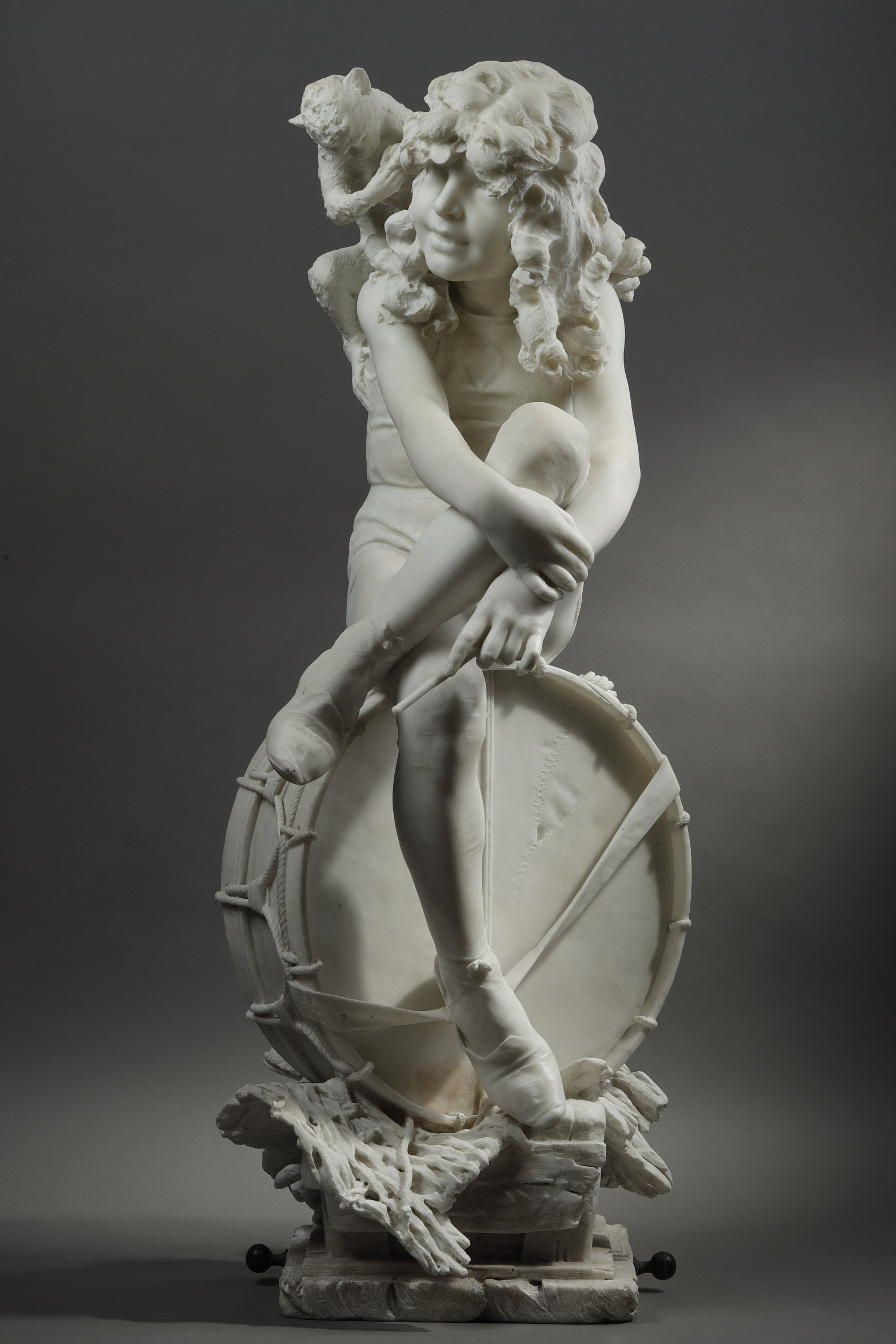
SALTIMBANCA
BY ENRICO ASTORRI
Description
This exquisite marble sculpture showcases a young saltimbanca, or female street acrobat, and her monkey, poised atop an intricately wrought drum as they await their next performance. Her countenance radiates a playful innocence and every strand of her hair, carved with striking realism, cascades in a canopy of luxurious curls to frame her face. The girl’s relaxed posture on the drum stands as a testament to the artist’s mastery of the sculptors art and his attention to nuance in the playful inclusion of a cheeky monkey to accentuate the child’s youthfulness and inherent sense of humour. The artist’s unparalleled artistry and expertise is evident in the drum’s surface which boasts remarkable attention to detail. From the finely carved cords and the meticulously crafted escutcheons to the texture of the drumhead, particularly the stitching on an old tear, the precision of his work is exquisite. The texture of the girl’s clothing and the intricate details of her physique are accentuated by a delicate play of light and shadow, bearing witness to the artist’s deep anatomical understanding. The elegantly outstretched leg, lightly suspended in the drum strap, endows the figure with a dynamic, flowing quality which contrasts harmoniously with the tranquillity of her facial expression.
The artist leads his audience on a contemplative journey of discovery full of the delight of uncovering subtle details such as the four classic card symbols. Astorri adds his characteristic touch of realism to this majestic piece through the skilfully crafted base. Representing a humble wooden crate resting on a finely sculpted yet rustic net, Astorri adds yet another layer of depth to this masterpiece.
The italian sculptor Enrico Astorri (1859 – 1921)
ASTORRI or ASTONI, ENRICO was an esteemed Italian sculptor. Born in San Lazzaro Alberoni on 10 March 1859, he passed away in Milan on 15 October 1921. Having initially studied in Parma before moving to Genoa, he ultimately honed his craft in Milan, where he took up residence at an impressively young age.
His notable works include the monument to ‘Vittorio Emanuele II’ in Parma (1879), exhibitions in Turin (1884) featuring the marble statues ‘La sérénade’ and ‘Attraction’, and other significant contributions in Milan, Venice, and Bologna throughout the 1880s. His engagements extended to London exhibitions, and his prolificacy was evident in the latter part of the century, with extensive travels and commendations in Uruguay, Argentina, Russia, and beyond. His oeuvre can be found in public collections in Piacenza and Trieste.
Period
-
- ca. 1900
Material
-
- White Carrara marble
Dimensions
-
- Sculpture height : 122,50 cm
- Total height with original column in Serpentine marble: 212,00 cm
Signature
-
- Signed « Astorri E. co./Milano ».
THE GIRL AND THE LAMB BY CHARLES RAPHAËL PEYRE

The girl and the lam by Charles Raphaël Peyre
An Art Deco sculpture in white Carrara marble representing a young girl kissing a lamb.
An Art Deco sculpture in white Carrara marble representing a young girl kissing a lamb. This sculpture is a typical example of the Art Deco period, the long rectangular shape of the sculpture, the haircut of the girl and the stylized representation of the lamb’s wool.
The French sculptor Charles
Raphaël Peyre (1872 – 1949) The Sculpture is signed « Ch. Raphael Peyre » standing for Charles Raphaël Peyre (1872 – 1949), the French sculptor. Peyre is born in Paris. His teachers were the famous sculptors Falguière, Mercié and Th. Barrau. Peyre was fond of symbolic or allegorical subjects, which he exhibited at the Salon from 1893 onwards. He won an honourable mention in 1894, a third-class medal in 1902, a second-class medal in 1903 and finally a travel grant in 1903. He will be part of the Society of French Artists from 1900. A sculpture of the artist appears at the Château de Compiègne in France.
- 36,5 x 67 x 15,5 cm
- White Carrara marble sculpture.
- Paris circa 1910
- BENEZIT, E. Dictionnaire des peintres, sculpteurs, dessinateurs et graveurs. Paris: Librairie Gründ, 1961. Vol.6. p. 635.
- KJELLBERG, P. Les Bronzes du XIXe Siècle, Dictionnaire des sculpteurs. Paris : Les éditions de l’amateur, 1989. p. 541.
PEDROLINO BY JOSEPH WILLEMS

« Pedrolino » by joseph willems
Pedrolino, bust depicting a King’s fool. The sculpture is the result of a lost wax cast. It has a light brown patina.
Pedrolino, bust depicting a King’s fool. The sculpture is the result of a lost wax cast. It has a light brown patina.
The Sculpture is signed « J. Willems 1884 » standing for Joseph Willems and « Cie des Bronzes Bruxelles (cire perdue) » for the foundry « Compagnie des bronzes de Bruxelles (lost wax cast) ».
We have found only one other identical copy of Willems’ Pedrolino bust on the market during the last 20 years with a much worse cast quality.
Joseph Willems trained at the Academy of Mechelen from 1864 to 1867 with the sculptor Joseph Tuerlinckx (1809-1873). In 1867 he participated in his first competition organised by the Antwerp Fine Arts Society. He will win the first prize with his sculpture « Ruth gleaning on the Booz field » which will be executed in bronze by the Society to celebrate his victory. It will later even be executed in marble for the members of the Society.
In 1868 he went to Paris and enrolled at the Academy of Fine Arts. He was then appointed professor at the Academy of Fine Arts in Mechelen in 1872. This last promotion will allow him to receive many commissions from the city of Antwerp, such as: « two timpans » and the statues « Painters », « Sculptors », « Comedy » and « Tragedy » for the Flemish Theatre in 1870 or « Justice » for the Court House of Tournai in 1877,…
Abroad he will execute for Romania in 1899 a bronze statue of « Cargeù » which will be placed on the Grand’ Place of Turn Severino.
He also obtained various medals: a silver medal at the Universal Exhibition in London in 1884, a silver medal at Port Adelaide in 1887, a gold medal at Melbourne (1888),…, a gold medal at the Universal Exhibition in Berlin in 1891 for his sculpture « Job on his manure ».
Foundry :
– La Compagnie des Bronzes de Bruxelles : The largest Belgian art bronze foundry and one of the largest in Europe.
First created under the name « Comann et Compagnie » on July 6, 1854, it was renamed « Compagnie pour la fabrication du zinc et du bronze et des appareils d’éclairage » in 1859 and finally « Compagnie des Bronzes » in 1878. In 1878 the Company won a gold medal at the Universal Exhibition in Paris. In 1880 the Company’s shares were listed on the stock exchange and the Company had some 300 workers.
The foundry and the artist worked together for 2 years. We found correspondences between the artist and the foundry from November 1882 to November 1884.
- Height : 57 cm
- Base : Length x Width : 16 x 14,5 cm
- Bronze – Lost wax cas
- Model 1893 – Cast from 1894 (Lifetime cast)
- ENGELEN, C. MARX, M. Compagnie des Bronzes. Brussel: Algemeen Rijksarchief en Rijksarchief in de Provincien, 2002. p. 388-389.
- ENGELEN, C. MARX, M. La Sculpture en Belgique à partir de 1830. Louvain : Engelen – Marx, 2006. Tome VII p. 4220 – 4225.
COLLECTION OF BUST PORTRAITS BY GEORGES VAN DER STRAETEN

COLLECTION OF BUST PORTRAITS BY GEORGES VAN DER STRAETEN
Description
30 years of research were necessary for the gallery to assemble the 18 pieces of the collection of busts by the Belgian sculptor Georges Van der Straeten (1856 – 1941). This unique collection features portraits of Parisian women from the Comédie Française and the theater of ‘La Belle Époque’.
The belgian sculptor Georges Van der Straeten (1856 – 1941)
Van der Straeten abandonned in 1882 his career as a lawyer to dedicate his life to sculpture. He was a pupil of G. Kasteleyn and the famous Jef Lambeaux. Later he left Ghent for Paris where he stayed from 1883 untill his death in 1928. In Paris he met the belgian painters Jan Van Beers and Rik Wouters, with who he became good friends.
He excelled in portraits of young and elegant women in the taste of the 18th century painters as Watteau. Most of his extensive production were chryséléphantines and bronze sculptures.
Georges Van der Straeten received many rewards including the Silver medal at the world exhibition of 1900 and the French Medal of Honor in 1903.
Some of Georges Van der Straeten’s artworks can be found in the museum of Maubeuge in France and in the museum “Beaux-arts” in Brussels.
Material :
-
- Patinated bronze. Gilded bronze. Ivory.
- Marble and onyx bases.
Size :
-
- 16-20 cm (6.3 – 7.9 in)
Period :
-
- ca. 1900
DONNA ORIENTALISTA BY ANTONIO FRILLI
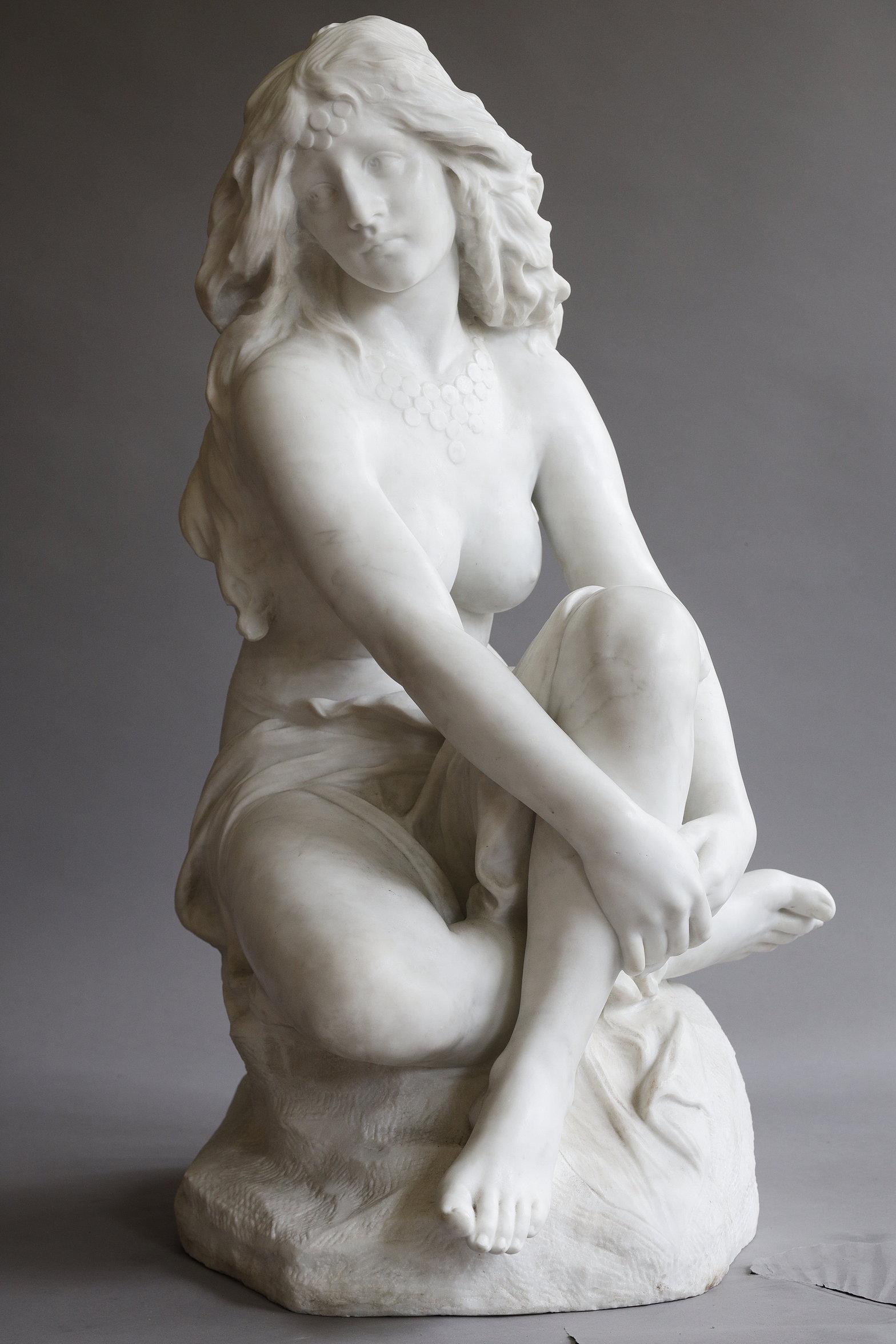
DONNA ORIENTALISTA BY ANTONIO FRILLI
Description
Donna Orientalista, also known as Orientalist Beauty, was created by the Italian sculptor Antonio Frilli (end of the 19th century). The sculpture represents beauty and exoticism, two trending themes of the era. It is supported by a stunning Serpentine green marble column. The sculptor impresses with this life-sized work and asserts his talent during the Art Deco movement.
The italian sculptor Antonio Frilli (Firenze c. 1880 – after 1921)
Antonio Frilli is one of the italian sculptors who excels in the Art Deco period. Altought little is known about the artist in literature, all the sculptures we found back from him testify great skill and virtuosity. Most sculpture that we examined were very popular at auctions around the world.
This sculpture is a perfect example of an Art Deco sculpture of high quality. The elegance of the subject, the details of the carving and the purity of the marble shows us how talented and precise the artist was.
We know that Antonio Frilli owned a well-known workshop in Florence and that he worked on several monuments, busts and funerary works. In 1921 Antonio worked on the monument “Caduti di Iano” with another sculptor Benso Vignolini.
Antonio Frilli is also the author of some works for Charles I of Hohenzollern, King of Romania.
Dimensions:
-
- Height: 94,00 cm (37 in).
- Total dimensions (with column): 194,50 cm (76 ½ in).
Material:
-
- White Carrara marble.
- Serpentine Green marble.
Period:
-
- ca. 1880.
ALLEGORY OF TRUTH OR BEAUTY BY PIERRE FEDERSPIEL
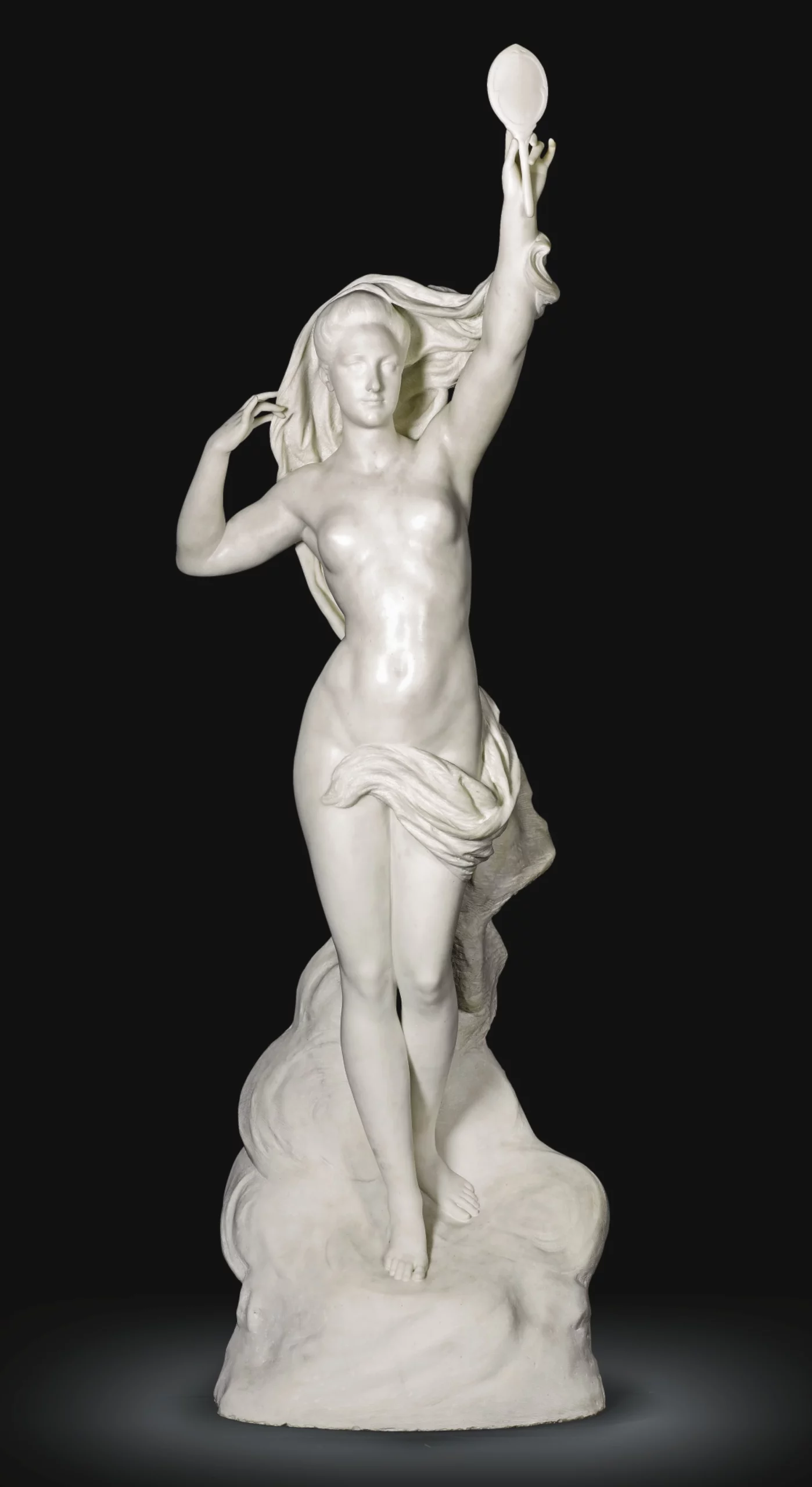
ALLEGORY OF TRUTH OR BEAUTY BY PIERRE FEDERSPIEL
Description
This spectacular marble is the most significant sculpture by the Luxembourgish Sculptor Pierre Federspiel, to some to auction, and it may be counted among his major works. Rising from a wave-like support in a beautiful S-curve, partially draped and holding up a mirror in her raised left hand, the present female nude is a testament to the sculptor’s skill and originality.
The luxembourgish sculptor Pierre Federspiel (1864-1924)
Although eclipsed in fame by his French confrères, Pierre Federspiel was Luxembourg’s foremost sculptor of the late 19th and early 20th century. Having studied first at the Academy in Munich, then at the Académie Julian in Paris, Federspiel began his career as a pupil in the private studio of Alfred Boucher, the celebrated self-taught sculptor who was a close friend of Auguste Rodin. Federspiel first exhibited at the Cercle Artistique in Luxembourg in 1894, followed by several participations at the Paris Salon, recorded in 1889, 1890, 1892 and 1905.
Federspiel’s oeuvre ranged from public monuments to bourgeois portraiture. He executed several monumental sculptures for his native Luxembourg, including the Monument Dicks et Lentz at the Place d’Armes, the frieze with Countess Ermesinde on the façade of the Cercle Municipal, as well as the heads of historical figures which decorate the façade of the Gare Central. When representing personages of his time, such as Prince Henri, Joseph Junk, and various women of society, Federspiel was known for employing a bourgeois realism, emphasising their contemporary dress and demeanour. Pierre Federspiel was revered by his fellow countrymen, and his legacy survives in the Luxembourgish street that was named after him.
Material
-
- White Carrara marble.
Overall size
-
- 204 cm
Period
-
- ca. 1900
Provenance
-
- Entrance hall, Avenue des Amandiers 1, Brussels, Belgium.
- Sold in London in May 2016.
Nil Virtuti Invium by Henri Gauquié

“Nil Virtuti Invium”
by Henri Gauquié
« Nil Virtuti Invium » is a tour de force of 19th-century French sculpture, capturing both the human condition and the complexity of physical form.
The intricate details are impeccably executed, from the sinewy tension in the muscles to the fine contours of the entangling rope. The form appears arrested in a moment of struggle, encapsulating the timeless conflict between human will and external forces. The artistic philosophy behind this piece echoes the grand themes of existentialism and fortitude, prevalent during the late 19th century.
The french sculptor Henri Gauquié (1858 – 1927)
Henri Gauquié was a distinguished French sculptor born in 1858 and active during the late 19th and early 20th centuries. He was renowned for his depictions of human and animal forms, often rendered in bronze and marble. Gauquié studied under famous mentors like Emmanuel Frémiet and exhibited his works at the Salon des Artistes Français, earning various awards and distinctions. His works are part of significant public and private collections and are a tribute to his technical mastery and emotional depth.
Dimensions :
- Height 90 cm (35 inch)
- Width 59.5 cm (23 inch)
- Depth 30.5 cm (12 inch)
- White Carrara marble sculpture.
The sculpture has an illustrious provenance, having been acquired by a Dutch family at the TEFAF in Maastricht in 2005.
- 19th Century
- Benezit Dictionary of Artists, Editions Gründ, 2006
- “French Sculpture 1800-1825,” by Christopher Payne
- “Henri Gauquié: A Retrospective,” Catalogue by [Museum/Institution]
- « The Impact of the Salon des Artistes Français in the 19th Century, » by Elaine Evans Dee
- « TEFAF Maastricht and its Influence on the Art Market, » by Jorrit van der Waal
Archives
Catégories
- Aucune catégorie
